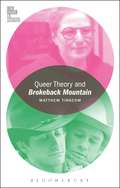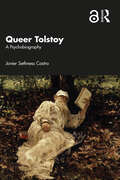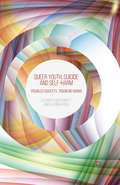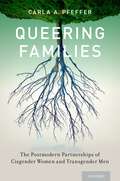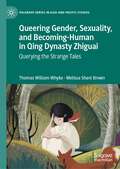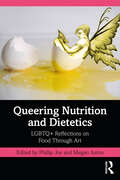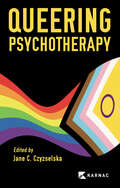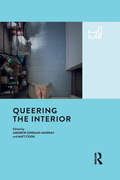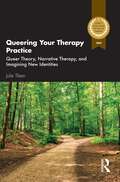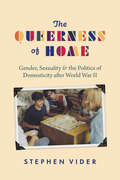- Table View
- List View
Queer Theory and Brokeback Mountain (Film Theory in Practice)
by Matthew TinkcomQueer Theory and Brokeback Mountain examines queer theory as it has emerged in the past three decades and discusses how Brokeback Mountain can be understood through the terms of this field of scholarship and activism. Organized into two parts, in the first half the author discusses key canonical texts within queer theory, including the work of writers as Judith Butler, Michel Foucault, and Eve Kosofsky Sedgwick. He provides an historical account of the questions these scholars have posed to our understanding of sexualities-both normative and non-normative-in the historical past and in contemporary life, as well as a discussion of the theories of sexuality and gender offered by these scholars as these phenomena shape the experiences of men and women in the genital, bodily, erotic, discursive, and cultural dimensions.The second part examines Ang Lee's 2005 feature film, Brokeback Mountain, in order to understand the claims and insights of queer theory. Tracing the film's adaptation by screenwriter Larry McMurtry of Annie Proulx's 1997 short story of the same title, this portion of the book examines the film's narrative about two working-class men in the rural mid-20th-century U.S. and the meanings of the sexual and emotional bond between the pair that develops over the course of two decades.
Queer Theory and Brokeback Mountain (Film Theory in Practice)
by Matthew TinkcomQueer Theory and Brokeback Mountain examines queer theory as it has emerged in the past three decades and discusses how Brokeback Mountain can be understood through the terms of this field of scholarship and activism. Organized into two parts, in the first half the author discusses key canonical texts within queer theory, including the work of writers as Judith Butler, Michel Foucault, and Eve Kosofsky Sedgwick. He provides an historical account of the questions these scholars have posed to our understanding of sexualities-both normative and non-normative-in the historical past and in contemporary life, as well as a discussion of the theories of sexuality and gender offered by these scholars as these phenomena shape the experiences of men and women in the genital, bodily, erotic, discursive, and cultural dimensions.The second part examines Ang Lee's 2005 feature film, Brokeback Mountain, in order to understand the claims and insights of queer theory. Tracing the film's adaptation by screenwriter Larry McMurtry of Annie Proulx's 1997 short story of the same title, this portion of the book examines the film's narrative about two working-class men in the rural mid-20th-century U.S. and the meanings of the sexual and emotional bond between the pair that develops over the course of two decades.
Queer Tolstoy: A Psychobiography
by Javier Sethness CastroQueer Tolstoy is a multidimensional work combining psychoanalysis, political history, LGBTQ+ studies, sexology, ethics, and theology to explore the life and art of Count Lev Nikolaevich Tolstoy. Using a psychobiographical framework, Sethness Castro uncovers profoundly queer dimensions in Tolstoy’s life experiences and art. Deftly contributing to the progressive and radical analysis of gender and sexuality, this book examines how Tolstoy’s erotic dissidence informed his anarchist politics, anti-militarist ideals, and voluminous literary production. Sethness Castro analyzes the influence of Buddha, Socrates, Jesus, Cervantes, Rousseau, Kant, Herzen, Proudhon, Chernyshevsky, and his mother Marya Volkonskaya on the artist's writings. Furthermore, he details Tolstoy's emblematic linking of LGBTQ+ desire with moral and erotic self-determination and resistance to Tsarist despotism—especially in War and Peace. This book is vital reading for those interested in the intersection of literature, psychoanalysis, queer studies, and Russian history.
Queer Tolstoy: A Psychobiography
by Javier Sethness CastroQueer Tolstoy is a multidimensional work combining psychoanalysis, political history, LGBTQ+ studies, sexology, ethics, and theology to explore the life and art of Count Lev Nikolaevich Tolstoy. Using a psychobiographical framework, Sethness Castro uncovers profoundly queer dimensions in Tolstoy’s life experiences and art. Deftly contributing to the progressive and radical analysis of gender and sexuality, this book examines how Tolstoy’s erotic dissidence informed his anarchist politics, anti-militarist ideals, and voluminous literary production. Sethness Castro analyzes the influence of Buddha, Socrates, Jesus, Cervantes, Rousseau, Kant, Herzen, Proudhon, Chernyshevsky, and his mother Marya Volkonskaya on the artist's writings. Furthermore, he details Tolstoy's emblematic linking of LGBTQ+ desire with moral and erotic self-determination and resistance to Tsarist despotism—especially in War and Peace. This book is vital reading for those interested in the intersection of literature, psychoanalysis, queer studies, and Russian history.
Queer Voices in the Works of Richard von Krafft-Ebing, 1883–1901 (Genders and Sexualities in History)
by Douglas PretsellThis book is a critical edition of the autobiographical case studies used by the Austro-German psychiatrist Richard von Krafft-Ebing between 1883 and 1901. Forty-one individual case studies of same-sex attracted men and women, in their own words, made an eye-catching component of Krafft-Ebing’s most important work, PsychopathiaSexualis. Although the psychiatrist probably edited the autobiographical case studies, with the racier passages rendered in rather rudimentary Latin, what is particularly remarkable is that he preserved an unmistakeable queer discourse in some of the case studies that disputed the pathologising ideologies of the psychiatric texts in which they were embedded. Most of the autobiographies of same-sex attracted men follow the discursive patterns established in nineteenth-century psychiatry in providing descriptions of body features including genital size and shape, mental and physical health, family histories of health and disease, and accounts of life events from childhood to the present. This was because these men had been following Krafft-Ebing’s works and were now using their autobiographical contributions in Psychopathia Sexualis as a platform for negotiating the parameters of sexual orientation. Women’s sexuality was a relatively undeveloped component of Krafft-Ebing’s sexology but there are four case studies of women containing autobiographical content. Similarly, gender variance was hardly differentiated from sexuality at this period, but there are three autobiographies that clearly articulate cross gender identification, anticipating the future categories of transsexual and transgender. Krafft-Ebing reserved his therapeutic interventions to those individuals attracted to both sexes where hypnosis could supress same sex urges. Seven of these individuals supplied sexual autobiographies with two of them undergoing treatment as part of the overall case study. Together, these forty-one accounts give the reader a window into queer self-conceptions in Austria and Germany as the nineteenth century drew to a close.
Queer Youth, Suicide and Self-Harm: Troubled Subjects, Troubling Norms
by E. McDermott K. RoenOffering a new way of understanding the high self-harm and suicide rates among sexual and gender minority youth, this book prioritises the perspectives and experiences of queer young people, including those who have experience of self-harming and/or feeling suicidal. Presenting analysis based on research carried out with young people both online and face-to-face, the authors offer a critical perspective on the role of norms, namely developmental norms, gender and sexuality norms, and neoliberal norms, in the production of self-harming and suicidal youth. Queer Youth, Suicide and Self-Harm is unique in the way it works at the intersection of class and sexuality, and in its specific focus on transgender youth and the concept of embodied distress. It also examines the implications of this research for self-harm reduction and suicide prevention.
Queering Critical Literacy and Numeracy for Social Justice: Navigating the Course (Queer Studies and Education)
by Summer Melody PennellThis volume explores the value of using queer pedagogy in an interdisciplinary middle school classroom to promote a better understanding of social justice and the social construction of knowledge among students. In the course of the study, which combined student-centered literacy and mathematical inquiries through a social justice lens, students used critical literacy skills to research social justice topics, learned to read numerical data like traditional print text, and created and solved their own math problems. In bringing together critical mathematics and critical literacy through a queer lens, the author offers new ways of thinking that challenges norms and helps students embrace new concepts of learning for the modern era.
Queering Families: The Postmodern Partnerships of Cisgender Women and Transgender Men (Sexuality, Identity, and Society)
by Carla A. PfefferOzzie and Harriet, move over. A new couple is moving into the neighborhood. In the postmodern era, advances in medical technologies allow some individuals categorized female at birth to live in accordance with their gender identities, as men. While a growing body of literature on transgender men's experiences has come to the forefront, relatively little exists to document the experiences of their partners. In Queering Families: The Postmodern Partnerships of Cisgender Women and Transgender Men, Carla A. Pfeffer brings these experiences to light through interviews with the group most likely to partner and form families with transgender men: non-transgender (cisgender) women. Drawing upon in-depth interviews with fifty cisgender women partners of transgender men from across the United States and Canada, Pfeffer details the experiences of a community that often seems unremarkable and ordinary on its surface. Cisgender women who partner with transgender men who are socially "read" as male are often (mis)perceived as part of a heterosexual couple or family. Yet not all cisgender women who partner with transgender men are comfortable with this invisible existence and comfortable normativity. Instead, many of the cisgender women Pfeffer interviews hold deeply-valued queer identities that may be erased in their partnerships with transgender men. Queering Families details the struggles and strengths of these postmodern "Harriets" as they work to build identities, partnerships, families, and communities. Pfeffer's interviewees discuss the implications of visibility and invisibilty in their everyday lives as they face barriers or pathways to legal and social inclusion. They carve out new lexicons for partners' bodies and their own sexualities, transformed through gender-affirming hormones and surgeries. They plan and construct families with and without children, some drawing upon alternative reproductive technologies to bear the biological offspring of their transgender partners. With remarkable depth and insight, Queering Families explores a shifting social landscape that challenges the very notion of what constitutes a "same-sex" or an "opposite-sex" relationship, marriage, or family.
Queering Families: The Postmodern Partnerships of Cisgender Women and Transgender Men (Sexuality, Identity, and Society)
by Carla A. PfefferOzzie and Harriet, move over. A new couple is moving into the neighborhood. In the postmodern era, advances in medical technologies allow some individuals categorized female at birth to live in accordance with their gender identities, as men. While a growing body of literature on transgender men's experiences has come to the forefront, relatively little exists to document the experiences of their partners. In Queering Families: The Postmodern Partnerships of Cisgender Women and Transgender Men, Carla A. Pfeffer brings these experiences to light through interviews with the group most likely to partner and form families with transgender men: non-transgender (cisgender) women. Drawing upon in-depth interviews with fifty cisgender women partners of transgender men from across the United States and Canada, Pfeffer details the experiences of a community that often seems unremarkable and ordinary on its surface. Cisgender women who partner with transgender men who are socially "read" as male are often (mis)perceived as part of a heterosexual couple or family. Yet not all cisgender women who partner with transgender men are comfortable with this invisible existence and comfortable normativity. Instead, many of the cisgender women Pfeffer interviews hold deeply-valued queer identities that may be erased in their partnerships with transgender men. Queering Families details the struggles and strengths of these postmodern "Harriets" as they work to build identities, partnerships, families, and communities. Pfeffer's interviewees discuss the implications of visibility and invisibilty in their everyday lives as they face barriers or pathways to legal and social inclusion. They carve out new lexicons for partners' bodies and their own sexualities, transformed through gender-affirming hormones and surgeries. They plan and construct families with and without children, some drawing upon alternative reproductive technologies to bear the biological offspring of their transgender partners. With remarkable depth and insight, Queering Families explores a shifting social landscape that challenges the very notion of what constitutes a "same-sex" or an "opposite-sex" relationship, marriage, or family.
Queering Fat Embodiment (Queer Interventions)
by Samantha Murray Cat Pausé Jackie WykesCultural anxieties about fatness and the attendant stigmatisation of fat bodies, have lent a medical authority and cultural legitimacy to what can be described as ’fat-phobia’. Against the backdrop of the ever-growing medicalisation, pathologisation, and commodification of fatness, coupled with the moral panic over an alleged ’obesity epidemic’, this volume brings together the latest scholarship from various critical disciplines to challenge existing ideas of fat and fat embodiment. Shedding light on the ways in which fat embodiment is lived, experienced, regulated and (re)produced across a range of cultural sites and contexts, Queering Fat Embodiment destabilises established ideas about fat bodies, making explicit the intersectionality of fat identities and thereby countering the assertion that fat studies has in recent years reproduced a white, ableist, heteronormative subjectivity in its analyses. A critical queer examination on fatness, Queering Fat Embodiment will be of interest to scholars of cultural and queer theory, sociology and media studies, working on questions of embodiment, stigmatisation and gender and sexuality.
Queering Fat Embodiment (Queer Interventions)
by Samantha Murray Cat Pausé Jackie WykesCultural anxieties about fatness and the attendant stigmatisation of fat bodies, have lent a medical authority and cultural legitimacy to what can be described as ’fat-phobia’. Against the backdrop of the ever-growing medicalisation, pathologisation, and commodification of fatness, coupled with the moral panic over an alleged ’obesity epidemic’, this volume brings together the latest scholarship from various critical disciplines to challenge existing ideas of fat and fat embodiment. Shedding light on the ways in which fat embodiment is lived, experienced, regulated and (re)produced across a range of cultural sites and contexts, Queering Fat Embodiment destabilises established ideas about fat bodies, making explicit the intersectionality of fat identities and thereby countering the assertion that fat studies has in recent years reproduced a white, ableist, heteronormative subjectivity in its analyses. A critical queer examination on fatness, Queering Fat Embodiment will be of interest to scholars of cultural and queer theory, sociology and media studies, working on questions of embodiment, stigmatisation and gender and sexuality.
Queering Gender, Sexuality, and Becoming-Human in Qing Dynasty Zhiguai: Querying the Strange Tales (Palgrave Series in Asia and Pacific Studies)
by Thomas William Whyke Melissa Shani BrownThis book offers queer readings of Chinese Qing Dynasty zhiguai, ‘strange tales’, a genre featuring supernatural characters and events. In a unique approach interweaving Chinese philosophies alongside critical theories, this book explores tales which speak to contemporary debates around identity and power. Depictions of porous boundaries between humans and animals, transformations between genders, diverse sexualities, and contextually unusual masculinities and femininities, lend such tales to queer readings. Unlike previous scholarship on characters as allegorical figures or stories as morality tales, this book draws on queer theory, animal studies, feminism, and Deleuzian philosophy, to explore the ‘strange’ and its potential for social critique. Examining such tales enriches the scope of historic queer world literatures, offering culturally situated stories of relationships, desires, and ways of being, that both speak to and challenge contemporary debates.
Queering Gestalt Therapy: An Anthology on Gender, Sex & Relationship Diversity in Psychotherapy
by Ayhan Alman John Gillespie Vikram KolmannskogThe first peer-reviewed book of its kind, this important volume addresses a current gap in the field of gestalt therapy: that the practice—and psychotherapy more broadly—still suffers from pervasive hetero- and cis-normativity. This book offers gestalt-therapy-based research and training material on gender, sex, and relationship diversity (GSRD), including chapters on a variety of GSRD issues and how therapists can become more GSRD-sensitive. The contributors position themselves across the whole spectrum of GSRD and offer their voices as an invitation to further queer the gestalt community with diverse content ranging from academic, research-oriented pieces to experiential, reflective perspectives. Featured chapters explore topics including gender-radical clients, sex and sexuality, relationship diversity, integrating GSRD and gestalt therapy, and addressing heteronormativity in gestalt therapy training. Queering Gestalt Therapy is for everyone who is interested in gender, sex, and relationship diversity, especially as they relate to gestalt therapy practice. This book will be especially useful for therapists, supervisors, coaches, and students of gestalt therapy.
Queering Gestalt Therapy: An Anthology on Gender, Sex & Relationship Diversity in Psychotherapy
The first peer-reviewed book of its kind, this important volume addresses a current gap in the field of gestalt therapy: that the practice—and psychotherapy more broadly—still suffers from pervasive hetero- and cis-normativity. This book offers gestalt-therapy-based research and training material on gender, sex, and relationship diversity (GSRD), including chapters on a variety of GSRD issues and how therapists can become more GSRD-sensitive. The contributors position themselves across the whole spectrum of GSRD and offer their voices as an invitation to further queer the gestalt community with diverse content ranging from academic, research-oriented pieces to experiential, reflective perspectives. Featured chapters explore topics including gender-radical clients, sex and sexuality, relationship diversity, integrating GSRD and gestalt therapy, and addressing heteronormativity in gestalt therapy training. Queering Gestalt Therapy is for everyone who is interested in gender, sex, and relationship diversity, especially as they relate to gestalt therapy practice. This book will be especially useful for therapists, supervisors, coaches, and students of gestalt therapy.
Queering Nutrition and Dietetics: LGBTQ+ Reflections on Food Through Art
by Phillip Joy Megan AstonThis book presents experiences of LGBTQ+ people relating to food, bodies, nutrition, health, wellbeing, and being queer through critical writing and creative art. The chapters bring LGBTQ+ voices into the spotlight through arts-based scholarship and contribute to experiential learning, allowing for more understanding of the lives of LGBTQ+ people within the dietetic profession. Divided into three parts, the first explores eating, food, and bodies; the second discusses communities, connections, and celebrations; and the final part covers care in practice. Topics include body image, eating disorders, weight stigma, cooking and culinary journeys, queer food culture, queer practices in nutrition counseling, and gendered understandings of nutrition. Exploring not only experiences of marginalization, homophobia, transphobia, and cisheteronormativity within dietetics and nutritional healthcare, this collection also dives into the positive connections and supportive communities that food can create. Special attention is paid to the intersections of oppression, colonialism, social justice, and politics. This book will be beneficial to all health professionals, educators, and students creating and fostering safer, more inclusive, and more accepting environments for their LGBTQ+ clients.
Queering Nutrition and Dietetics: LGBTQ+ Reflections on Food Through Art
by Phillip Joy and Megan AstonThis book presents experiences of LGBTQ+ people relating to food, bodies, nutrition, health, wellbeing, and being queer through critical writing and creative art. The chapters bring LGBTQ+ voices into the spotlight through arts-based scholarship and contribute to experiential learning, allowing for more understanding of the lives of LGBTQ+ people within the dietetic profession. Divided into three parts, the first explores eating, food, and bodies; the second discusses communities, connections, and celebrations; and the final part covers care in practice. Topics include body image, eating disorders, weight stigma, cooking and culinary journeys, queer food culture, queer practices in nutrition counseling, and gendered understandings of nutrition. Exploring not only experiences of marginalization, homophobia, transphobia, and cisheteronormativity within dietetics and nutritional healthcare, this collection also dives into the positive connections and supportive communities that food can create. Special attention is paid to the intersections of oppression, colonialism, social justice, and politics. This book will be beneficial to all health professionals, educators, and students creating and fostering safer, more inclusive, and more accepting environments for their LGBTQ+ clients.
Queering Psychotherapy
by Jane Chance CzyzselskaLGBTIQ+ people are more likely than cisgender and heterosexual individuals to suffer with mental health issues, yet often have poorer therapeutic outcomes. Mainstream Eurocentric psychotherapeutic theories, developed largely by heterosexual, cisgender and white theorists, tend to see LGBTIQ+ as a singular group through this “othered” lens. Despite the undeniable value offered by many of these theories, they and those who use them – queer therapists included – can often pathologize, marginalize, misunderstand and diminish the flourishing and diversity of queer experience. In this volume, editor and psychotherapist Jane C. Czyzselska speaks with practitioners and clients from diverse modalities and lived experiences, exploring and rethinking some of the unique challenges encountered in a world that continues to marginalize queer lives. The contributors to Queering Psychotherapy present key insights and practical advice in a dynamic conversational format, providing intimate access to therapists’ personal and professional knowledge and reflections. This book is an invaluable training in itself.
Queering the Interior (Home)
by Andrew Gorman-MurrayQueering the Interior problematizes the familiar space of ‘home’. It deploys a queer lens to view domestic interiors and conventions and uncovers some of the complexities of homemaking for queer people.Each of the book’s six sections focuses on a different room or space inside the home. The journey starts with entryways, and continues through kitchens, living spaces, bedrooms, bathrooms, and finally, closets and studies. In each case up to three specialists bring their disciplinary expertise and queer perspectives to bear. The result is a fascinating collection of essays by scholars from literary studies, geography, sociology, anthropology, history and art history. The contributors use historical and sociological case studies; spatial, art and literary analyses; interviews; and experimental visual approaches to deliver fresh, detailed and grounded perspectives on the home and its queer dimensions. A highly creative approach to the analysis of domestic spaces, Queering the Interior makes an important contribution to the fields of gender studies, social and cultural history, cultural studies, design, architecture, anthropology, sociology, and cultural geography.
Queering the Interior (Home)
by Andrew Gorman-Murray Matt CookQueering the Interior problematizes the familiar space of ‘home’. It deploys a queer lens to view domestic interiors and conventions and uncovers some of the complexities of homemaking for queer people.Each of the book’s six sections focuses on a different room or space inside the home. The journey starts with entryways, and continues through kitchens, living spaces, bedrooms, bathrooms, and finally, closets and studies. In each case up to three specialists bring their disciplinary expertise and queer perspectives to bear. The result is a fascinating collection of essays by scholars from literary studies, geography, sociology, anthropology, history and art history. The contributors use historical and sociological case studies; spatial, art and literary analyses; interviews; and experimental visual approaches to deliver fresh, detailed and grounded perspectives on the home and its queer dimensions. A highly creative approach to the analysis of domestic spaces, Queering the Interior makes an important contribution to the fields of gender studies, social and cultural history, cultural studies, design, architecture, anthropology, sociology, and cultural geography.
Queering Your Therapy Practice: Queer Theory, Narrative Therapy, and Imagining New Identities
by Julie TilsenQueering Your Therapy Practice: Queer Theory, Narrative Therapy, and Imagining New Identities is the first practice-based book for therapists that presents queer theory and narrative therapy as praxis allies. This book offers fresh, hopeful resources for therapists committed to culturally responsive work with queer and trans people and the important others in their lives. It features clinical vignettes from the author’s practice that bring to life the application of queer theory through the practice of narrative therapy and serve as teaching tools for the specific concepts and practices highlighted in individual, relational, and family therapy contexts. The text also weaves in questions for reflection and discussion, and Q-tips summarizing key points and practices. A practical resource for both seasoned therapists and students, Queering Your Practice Theory demonstrates how therapeutic practice can be informed, improved, and deepened by queer theory.
Queering Your Therapy Practice: Queer Theory, Narrative Therapy, and Imagining New Identities
by Julie TilsenQueering Your Therapy Practice: Queer Theory, Narrative Therapy, and Imagining New Identities is the first practice-based book for therapists that presents queer theory and narrative therapy as praxis allies. This book offers fresh, hopeful resources for therapists committed to culturally responsive work with queer and trans people and the important others in their lives. It features clinical vignettes from the author’s practice that bring to life the application of queer theory through the practice of narrative therapy and serve as teaching tools for the specific concepts and practices highlighted in individual, relational, and family therapy contexts. The text also weaves in questions for reflection and discussion, and Q-tips summarizing key points and practices. A practical resource for both seasoned therapists and students, Queering Your Practice Theory demonstrates how therapeutic practice can be informed, improved, and deepened by queer theory.
The Queerness of Home: Gender, Sexuality, and the Politics of Domesticity after World War II
by Stephen ViderVider uncovers how LGBTQ people reshaped domestic life in the postwar United States. From the Stonewall riots to the protests of ACT UP, histories of queer and trans politics have almost exclusively centered on public activism. In The Queerness of Home, Stephen Vider turns the focus inward, showing that the intimacy of domestic space has been equally crucial to the history of postwar LGBTQ life. Beginning in the 1940s, LGBTQ activists looked increasingly to the home as a site of connection, care, and cultural inclusion. They struggled against the conventions of marriage, challenged the gendered codes of everyday labor, reimagined domestic architecture, and contested the racial and class boundaries of kinship and belonging. Retelling LGBTQ history from the inside out, Vider reveals the surprising ways that the home became, and remains, a charged space in battles for social and economic justice, making it clear that LGBTQ people not only realized new forms of community and culture for themselves—they remade the possibilities of home life for everyone.
Querschnittlähmung - Schritte der Bewältigung: Die Kraft der Psyche
by Peter LudeDas Buch widmet sich erstmalig den subtilen psychischen Vorgängen der Bewältigung nach einer lebensbedrohlichen Verletzung. Auf der Basis neuester psychologischer Forschungsergebnisse sowie aus eigener Erfahrung berichtet der Autor unterhaltsam, spannend und zugleich wissenschaftlich fundiert über eine starke Mobilisierung psychischer Ressourcen, die eine Gegenrealität im positiven Sinne schaffen. In einer Situation, in der nichts angenehm ist, geht es ihm darum, aus kleinsten Ansätzen den Normalzustand zu entwickeln, um somit die subtilen Bewältigungsprozesse zu erkennen, sie auszubauen, erlebbar und erlernbar zu machen – anstatt sie „wegzubehandeln“.Bei diesen Vorgängen spielen Angehörige oder nahe Bezugspersonen eine wichtige Rolle - der Verarbeitungsprozess wird daher unter Einbezug des sozialen Umfeldes umfassend beleuchtet. Das Buch richtet sich an Betroffene und deren Angehörige sowie an Fachpersonen: Es öffnet den Blick für die Entwicklungsmöglichkeiten des nach erlittener Querschnittlähmung vollständig abhängigen Patienten hin zur Persönlichkeit mit Querschnittlähmung mit größtmöglicher Selbstständigkeit und Unabhängigkeit.
The Quest for Conscience and the Birth of the Mind
by Annie ReinerThis book offers a new perspective on conscience as an as yet unrealized human potential, but a potential toward which human beings are naturally driven. A distinction is made between a "mature" or "healthy" conscience - a "conscience capable of maturation" - and the classical notion of the superego; it also postulates that the two may represent two separate lines of development. Conscience is seen to be inseparable from consciousness; the development of a mature conscience is seen to have its foundation in the development of a true or authentic self, while the classical notion of the superego is viewed as an often pathological manifestation of this natural mental potential. Theological ideas are relevant to any discussion of morality, conscience and guilt. Freud's and Bion's perspectives on religion are closely examined, revealing fundamental differences in their views of the mind. The author incorporates the metaphysical perspective central to Bion's concept of "O" as fundamental to an understanding of the development of a healthy conscience.
The Quest for Conscience and the Birth of the Mind
by Annie ReinerThis book offers a new perspective on conscience as an as yet unrealized human potential, but a potential toward which human beings are naturally driven. A distinction is made between a "mature" or "healthy" conscience - a "conscience capable of maturation" - and the classical notion of the superego; it also postulates that the two may represent two separate lines of development. Conscience is seen to be inseparable from consciousness; the development of a mature conscience is seen to have its foundation in the development of a true or authentic self, while the classical notion of the superego is viewed as an often pathological manifestation of this natural mental potential. Theological ideas are relevant to any discussion of morality, conscience and guilt. Freud's and Bion's perspectives on religion are closely examined, revealing fundamental differences in their views of the mind. The author incorporates the metaphysical perspective central to Bion's concept of "O" as fundamental to an understanding of the development of a healthy conscience.
